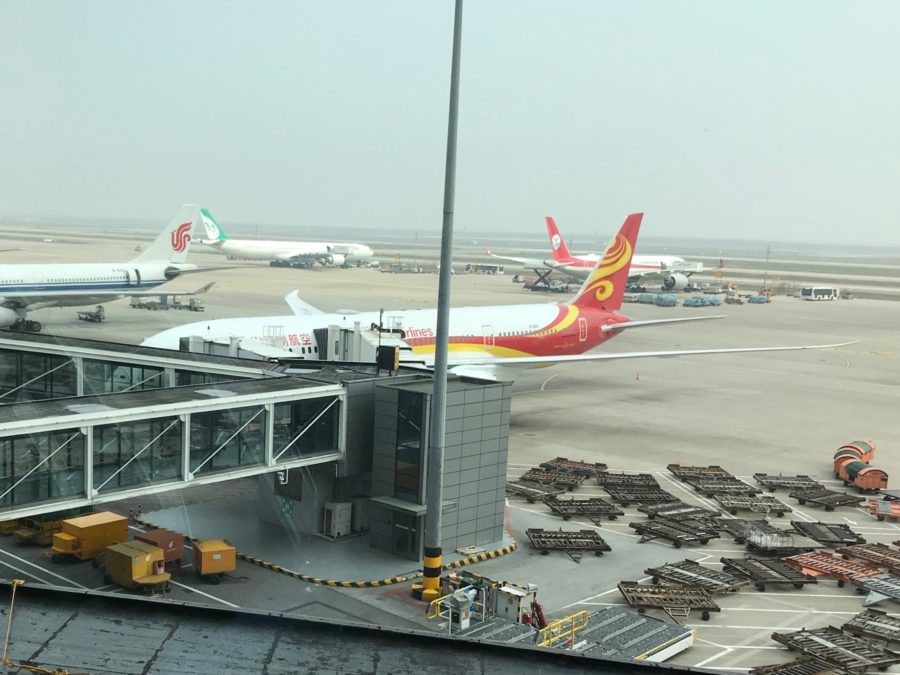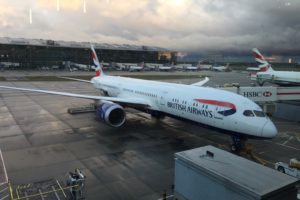Airline Profile: Hainan Airlines
The Facts:
| Alliance | N/A |
| Competitors | Air China China Eastern Airlines China Southern Airlines Shenzhen Airlines Sichuan Airlines |
| Fleet Count | 230 |
| Founded | 1993 |
| Frequent Flyer Program | Fortune Wings Club |
| Headquarters | Haikou, Hainan (China) |
| Hubs | Beijing Capital Aiprort Haikou Melian International Airport Xi’an Xianyang International Airport |
| Parent Company | HNA Group |
| Skytrax Rating | 5 (out of 5) |
| Subsidiaries | Air Chang’an Beijing Capital Airlines Fuzhou Airlines Grand China Air Lucky Air Tianjin Airlines Urumqi Air Hong Kong Airlines (minority stake) |
| Travel Classes | Economy Class Premium Economy Business Class |
| Type of Airline | Full Service |
| Website | http://hainanairlines.com/ |
Analysis:
6 Things You Need To Know About Hainan Airlines
- China has had a rule imposed on almost all long-haul routes which basically states that only one Chinese airline can fly on one individual long-haul route, which I (jokingly) call the “one-child policy of aviation.” It was implemented in 2009 and was created because many Chinese airlines are state-owned, and there’s no reason (for the Chinese government) to have competition on specific long-haul routes between the airline. The rule has been scaled back, although it still is for the most part in place. Since Hainan is relatively new and hadn’t been flying long-haul flights as long as the three legacy carriers had been doing out of their fortress hubs (Air China in Beijing, China Eastern in Shanghai, China Southern in Guangzhou), Hainan basically had to improvise. Hainan’s long-haul route structure currently involves flying from primary cities (Beijing, Shanghai) in China to secondary markets (such as San Jose, Boston, Prague) in North America, Europe, or Australia, or from flying from secondary cities in China (such as Changsha, Chongqing, or Xi’an) to primary markets around the world (such as Los Angeles, New York, or Paris).
- Because of this, Hainan Airlines doesn’t really have one place in China which they fly to the US from, which resulted in a pretty fractured route network. It’s interesting to note that since they fly mostly from secondary cities in China to the US only 2 or 3 times a week because each destination that they can fly to from the US doesn’t have the demand for a daily flight. From China to North America, they currently fly from New York JFK to Chengdu and Chongqing, from Boston to Beijing and Shanghai, from Chicago to Beijing and Chengdu, from Mexico City to Beijing via Tijuana, from Los Angeles to Changsha, Chengdu, Chongqing, and Xi’an, from San Jose to Beijing, from Seattle to Beijing and Shanghai, and from Vancouver to Shenzhen. All of the routes listed above are operated by Boeing 787-8s or Boeing 787-9s, besides the route from Seattle to Beijing.

- Hainan Airlines is China’s only Skytrax five-star airline and is only one of ten five-star airlines. It’s worthwhile to note that Skytrax isn’t all that reliable as they list Lufthansa as being a five-star airline. However, while I haven’t personally flown Hainan Airlines (although I have flown their subsidiary Hong Kong Airlines), Hainan does have an extraordinary reputation as easily being (mainland) China’s best airline with great service in business class and economy class and also having fantastic hard products in its premium classes.
- Hainan Airlines is owned by the HNA group, which also happens to own a great deal of other Chinese (and non-Chinese) airlines. These include small airlines such as Air Chang’an or Lucky Air, to larger airlines which also have long-haul flights such as Beijing Capital Airlines, Tianjin Airlines, or Hong Kong Airlines (fun fact: they share a livery with Hong Kong Airlines). They also interestingly enough have minority stake in quite a few non-Chinese airlines, such as France’s leisure airline Aigle Azur, Azul Brazilian Airlines, and even fully bought Ghana’s tiny Africa World Airlines which operates a fleet of Embraer E145s. The HNA group has been going through some financial difficulties, which have resulted in Hainan having to cancel or defer some orders (and some planes have been returned to lessors or were sold, including some A350s) and Hong Kong Airlines has had to significantly reduce their route map (although unsurprisingly, Hong Kong demand is really struggling now).
- Hainan Airlines’ fleet is mixed between Boeing and Airbus aircraft. They operate a large long-haul fleet of almost 35 Airbus A330s (both the -200 and -300 variants), 2 A350s (they sold two to South African Airways and will take delivery of a couple more), and 40 Boeing 787s, including 10 787-8s and 30 787-9s, with 8 more -9s on order. Their short-haul fleet consists solely of the Boeing 737, using the -800 variant (along with the 737 MAX, although as you know they are currently grounded), along with orders for 20 Chinese built Comac C919s, which will be a bit smaller than the the Airbus A320.
- Hainan Airlines tickets can be booked with Alaska Airlines miles, which is generally a pretty good deal, with flights from the US to China starting at only 30,000 miles one-way in economy class (which is okay) or 50,000 miles in business class (which is a great deal). Hainan airlines also charges their economy class and business class quite reasonably, with flights in economy costing as little as $300 round-trip and flights in business starting from about $1,500 round-trip, out of destinations such as Los Angeles or Seattle.
Travel Classes
Economy Class
Economy class is in a 3-3 configuration on all of Hainan’s 737s, a 2-4-2 configuration on all of their A330s, and is in a 3-3-3 configuration on all of their Boeing 787s and Airbus A350s. Personal on-demand entertainment and personal power outlets are available on all long-haul aircraft, including the A330, 787, and A350. Hainan Airlines provides full meal services on all flights longer than three hours, including on some domestic flights. On long-haul flights, Hainan does provide both Chinese and western options in economy class. Additionally, Hainan does provide amenity kits in economy class on long-haul flights, which include eye masks, ear plugs, and a toothbrush set, which is a rare feature for airlines to have in economy class. WiFi is available for purchase only on Hainan Airlines’ Boeing 787-9 aircraft

Premium Economy
Hainan Airlines only recently debuted their premium economy class product on its latest of three Boeing 787-9 cabin interiors and is flown only on a handful of routes to the US. Premium economy is currently only featured on 3 Boeing 787-9s (with more to come) and is in a 2-3-2 configuration and uses the Rockwell Collins MiQ seat, which is also used in premium economy on United, Delta, American, Cathay Pacific, among others (it’s a very popular seat). The seats are wider than economy class seats, have more recline, and have leg rests and footrests. Additionally, premium economy passengers receive priority check-in, priority boarding, larger entrainment screens, better in-flight pillows, blankets, and amenity kits, and better food.

Business Class
Hainan Airlines is known to have one of, if not (mainland) China’s very best business class among all Chinese airlines. Their soft product is known to be excellent, especially on long-haul flights, which includes great bedding (on long-haul flights) with pillows, a bed sheet, a duvet, and another blanket, is regarded for its fantastic in-flight meals with authentic Chinese food (the even have in-flight chefs!), good amenity kits, and pajamas on long-haul flights. Hainan Airlines operates airport lounges at Beijing Capital Airport and at Hangzhou Airport, although they use contract lounges at other airports which they operate from. Hainan Airlines uses quite a few seats in business class, some of which are better than others, which are listed and described below from worst to best.
Recliner (737): On Hainan Airlines’ Boeing 737s (both -800s and MAX 8s), which are solely used on domestic and short-haul flights, business class is equipped with recliner seats in a 2-2 configuration. The seats are equipped with leg rests, foot rests, and have in-flight entertainment screens which flip out of the armrest.
Fully Flat Safran Aura (787-8/787-9/A330-200): Hainan Airlines uses the Safran (formerly Zodiac) Aura seat in business class on all of their 787-8s an A330-200s, and on 10 of their Boeing 787-9s. The seats are in a 2-2-2 configuration on both of the aircraft types and have entertainment screens attached to the seat in front. While these seats aren’t very private and overall aren’t very good compared to some of the better business class seats out there, they are pretty comfortable and don’t have restrictive footwells like other seats do.

Staggered – Stelia Solstys (Airbus A330-300/Airbus A350-900): Hainan Airlines uses the Stelia Solstys seat on their Airbus A330-300s and on their Airbus A350-900s, although the A350s use a much improved version of the seat which is much more modern and has a better in-flight entertainment screen. These seats are in a 1-2-1 staggered configuration. Because of the staggered configuration, the seats by the window and in the center of the aircraft are much more private than the seats closer to the aisle, so make sure to choose a window seat if traveling alone in this configuration or choose two seats towards the center of the aircraft if traveling with a partner. I flew on Hong Kong Airlines this summer on their A350 in business class, which uses a very similar seat to the business class on their A350.

Reverse Herringbone – Safran Cirrus (Boeing 787-9): On 17 of Hainan Airlines’ Boeing 787-9s, they use the Safran (formerly Zodiac) Cirrus seat in business class. The seats are reverse herringbone seats and are in a 1-2-1 configuration and have the entertainment screen fold out of the seat in front.

Reverse Herringbone – Rockwell Collins Super Diamond (Boeing 787-9/Airbus A330-300): Hainan Airlines uses the Rockwell Collins Super Diamond seat on both their newest A330-300s and their newest 787-9s (the ones which have premium economy), although the two aircraft have different finishings in the cabin. The seats are in a reverse herringbone configuration and are in a 1-2-1 configuration. It’s quite rare for an airline to have two different business class seats on the same aircraft type, as Hainan uses both the Zodiac Cirrus and the Super Diamond on their 787-9s, which are both reverse herringbone seats, although the Super Diamond is much more spacious than the Cirrus (there are 26 seats instead of 30 seats on the 787-9).

Have you ever flown on Hainan Airlines? Share about your experience below in the comments section!




